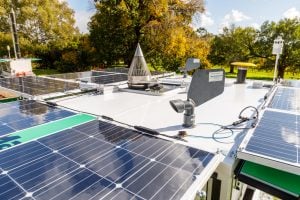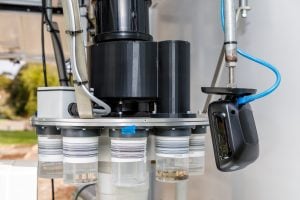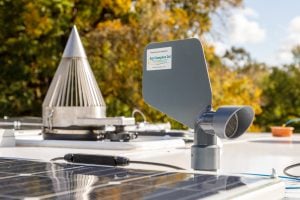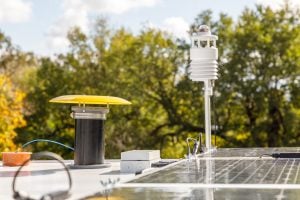The iMapPESTS project is testing out its mobile pest and disease ‘Sentinel’ traps at Langhorne Creek, 70km south of Adelaide.
The ‘Sentinel’ mobile unit is part of a nationwide R&D collaborative initiative between Australia’s major plant industries with the goal of developing a way to rapidly monitor and report the presence of airborne pests and diseases for multiple agricultural sectors, including viticulture, grains, cotton, sugar, horticulture and forestry.
“For the apple and pear industry, we will be looking to see if we trap and identify key flying pests such as Codling Moth, Light Brown Apple Moth, Helicoverpa, Apple Dimpling Bug, Rutherglen Bug, Queensland Fruit Fly, and others” said AUSVEG officer, Shakira Johnson.

Traps and monitoring equipment mounted on top of the Sentinel unit designed to trap airborne pests and fungal spores (Photo:iMapPESTS)

iMapPESTS Sentinel trailor parked and in operation (Photo: iMapPESTS)
It will lay the foundations for a nationally coordinated approach to surveillance that will provide growers with information which could be used to guide the direction or intensity of scouting efforts and pest control actions. The system could also facilitate a coordinated response to biosecurity efforts during exotic pest and disease incursions, including use in delimiting surveys and proof-of-freedom claims.
A key feature of the program is the Sentinel, a custom-designed surveillance trailer unit designed to offer optimal sampling of airborne fungal spores and insects. A prototype Sentinel was launched at South Australia’s premier agronomic cropping site in Hart last year. From there, the Sentinel was relocated to a research station in Nuriootpa, north-east of Adelaide, where it has been undergoing trials in plant pest surveillance in a viticulture region. It is now heading to major horticulture production areas in South Australia while it undergoes optimisation.
“We also have some capacity to monitor for black spot using a BioScout trap, and will be further testing and optimising that component” said Shakira.
The Sentinel is the first of a series of the specialised surveillance units to be developed by Primary Industries and Regions South Australia’s research division, the South Australian Research and Development Institute (SARDI), as part of the iMapPESTS program. SARDI lead scientist Dr Rohan Kimber is guiding the technology partners in the development and construction of the Sentinels. Once developed, the units will be deployed in growing regions across the country with the capacity to mobilise in response to industry and government surveillance needs.
The mobile nature of the Sentinel unit enables the surveillance technology to provide localised information that impacts a specific region, which might not apply to growing regions in other parts of the country.
The Sentinel is equipped with several airborne samplers, power supply, a climate sensor, telemetry and an industrial computer to remotely control and monitor the unit, including automated robotics to change pots on the samplers according to the day or capture criteria.

Sentinel sensing camera to allow remote monitoring (Photo: iMapPESTS)
The Sentinel features four different air samplers:
Two spore samplers, which are high-volume air samplers specifically designed to collect airborne spores
A two-metre insect suction trap to monitor localised insect dynamics
A six-metre insect suction trap, for monitoring of long-distance migratory insect flights
A BioScout system, a near real-time monitoring technology of fungal spores under collaboration.

Sentinel fungal spore trap with adjustable suction (Photo: iMapPESTS)

Sentinel weather station and air flow which provide data to integrate with pest and disease monitoring to allow grower alerts to be issued, such as Black Spot warnings (Photo: iMapPESTS)
The iMapPESTS research and development network has compiled a list of high priority pests for each major agricultural sector, with a focus on targets that affect multiple industries (eg. light brown apple moth affects the viticulture and pome fruit industries). After the Sentinel captures airborne pests and diseases – including many long-distance dispersal insects such as aphids and thrips – the samples will be dispatched to SARDI laboratories for inspection. The Sentinels are being optimised for new and established advanced diagnostics techniques developed by SARDI to identify and measure abundance of high-priority pests and diseases under surveillance. This research will expand the capacity of current airborne surveillance technology and diagnostic tools.
SARDI are examining the airborne samples captured by the Sentinel using highly specific and sensitive molecular techniques and assays which have been designed for the targets of interest. While this method of diagnostics is routine for pathogens, pests are traditionally identified by entomologists using morphological characteristics to identify species within samples. This is time consuming and in times of incursion or high pest and disease pressure, a timely response can make all the difference. The research and development of the application of these advanced techniques to pests will speed up identification and reporting, putting accurate, actionable information in the hands of growers to enhance pest management.
Meanwhile, some of the samples captured by the Sentinel are also being sent to Agriculture Victoria, which will investigate the application of new pest diagnostic techniques for the broadscale detection of exotic pests and diseases using next generation sequencing (NGS) technologies, which will be particularly useful in mixed population samples captured by the Sentinels. NGS sequencing means there will be high throughput capacity for pest and disease diagnostics.
This research will establish an NGS pipeline – samples collected in-field through to analysis – that will be made available to industry, as well as state and federal governments, on a fee-for-service basis that is affordable and sustainable.
The iMapPESTS team will work with growers and industry representatives to understand the best way to communicate and visualise the dynamic pest information for end users, sharing which pests or diseases the Sentinel is detecting in an area at a particular time. Growers and agronomists are encouraged to visit the iMapPESTS website for more information on surveillance outcomes.
The iMapPESTS: Sentinel Surveillance for Agriculture five-year program is a $21 million partnership, led by Hort Innovation, with funding from the Australian Government’s Rural R&D for Profit Program, as well as 16 partner organisations.
Acknowledgement: iMapPESTS is supported by Hort Innovation, through funding from the Australian Government Department of Agriculture as part of its Rural R&D for Profit Program and AgriFutures Australia, AUSVEG, CSIRO, Cotton Research and Development Corporation, Forest & Wood Products Australia, Nursery & Garden Industry Australia, Plant & Food Research, Rothamsted Research, PIRSA-SARDI, Sugar Research Australia, DJPR, the Western Australian Department of Primary Industries and Regional Development, Wine Australia and Burkard Agri Limited.
Further information:
iMapPESTS website www.imappests.com.au
Twitter: @iMapPESTS
About the author:
Shakira Johnson
Engagement and Adoption for iMapPESTS
M: 0433 937 564
E:
sh*************@au****.au

